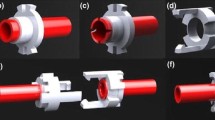Abstract
Many researchers have investigated microvascular anastomoses by scanning electron microscope (SEM); however, there are neither reports on classifying these anastomotic types according to the SEM results nor about studying the factors that affect these results. Sixty rat femoral arteries were anastomosed using four different techniques: simple interrupted, continuous, sleeve, and autogenous arterial cuff. The anastomotic sites of each group and other two intact femoral arteries were examined by SEM. Intimal disruption and rebuilding of the blood vessel endothelium after microvascular anastomoses depend upon anastomotic time; suture placement, either intra-luminal or extra-luminal; and mechanical factors. Accordingly, the simple interrupted suture technique has the highest degree of intimal disruption and the lowest degree of regeneration, the continuous and cuff anastomoses have better rebuilding with partial neo-endothelial coverage of the cut ends, whereas the sleeve anastomosis has the best regeneration with complete coverage of the cut ends by the new endothelial cells.








Similar content being viewed by others
References
Shimamoto T, Yamashita Y, Sunaga T (1969) Scanning electron microscopic observations of endothelial surface of heart and blood vessels, the discovery of intercellular bridge of vascular endothelium. Proc Jap Acad 45:507–513
Christen BC, Garbarsch C (1972) A scanning electron microscopic (S.E.M.) study on the endothelium of the normal rabbit aorta. Angiologica 9:15–26
Reichle FA, Stewart GJS, Essa N (1973) Transmission and scanning electron microscopic study of luminal surfaces in Dacron and autogenous vein bypasses in man and dog. Surgery 74:945–960
Gelder PA, Klopper PJ (1979) Healing of microvascular arterial anastomoses, as seen on corrosion casts by scanning electron microscopy. Plast Reconstr Surg 64:59–64
Lauritzen C, Hansson HA (1980) Microvascular repair after the sleeve anastomosis. An ultrastructural study in the rat femoral vessels. Scand J Plast Reconstr Surg 14:65–70
Weinstein PR, Maximilian MH, Szabo Z (1979) Microsurgical anastomosis, vessel injury, regeneration, and repair. In: Serafin D, Buncke HJ (eds) Microsurgical composite tissue transplantation. CV Mosby, St. Louis, pp 111–174
Pagnanelli DM, Pait TG, Rizzoli HV, Kobrine AI (1980) Scanning electron micrographic study of vascular lesion caused by microvascular needles and suture. J Neurosurg 53:32–36
Isogai N, Kamiishi H, Chichibu S (1988) Reendothelialization stages at the microvascular anastomosis. Microsurgery 9:87–94
Acknowledgment
The authors would like to thank the Continuing Medical Education Center and its Microsurgery Laboratory, Assiut Faculty of Medicine, Egypt.
Author information
Authors and Affiliations
Corresponding author
Rights and permissions
About this article
Cite this article
El-Shazly, M., Aly, K., Hifny, M. et al. Scanning electron microscopy in different techniques of microvascular anastomoses: categorization and factors affecting. A descriptive work. Eur J Plast Surg 30, 195–200 (2007). https://doi.org/10.1007/s00238-007-0169-z
Received:
Accepted:
Published:
Issue Date:
DOI: https://doi.org/10.1007/s00238-007-0169-z




